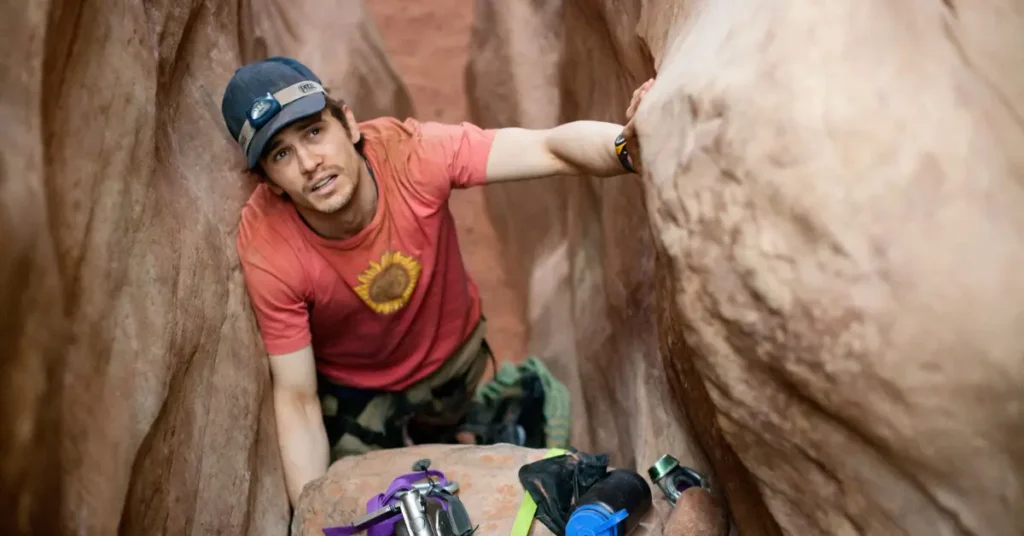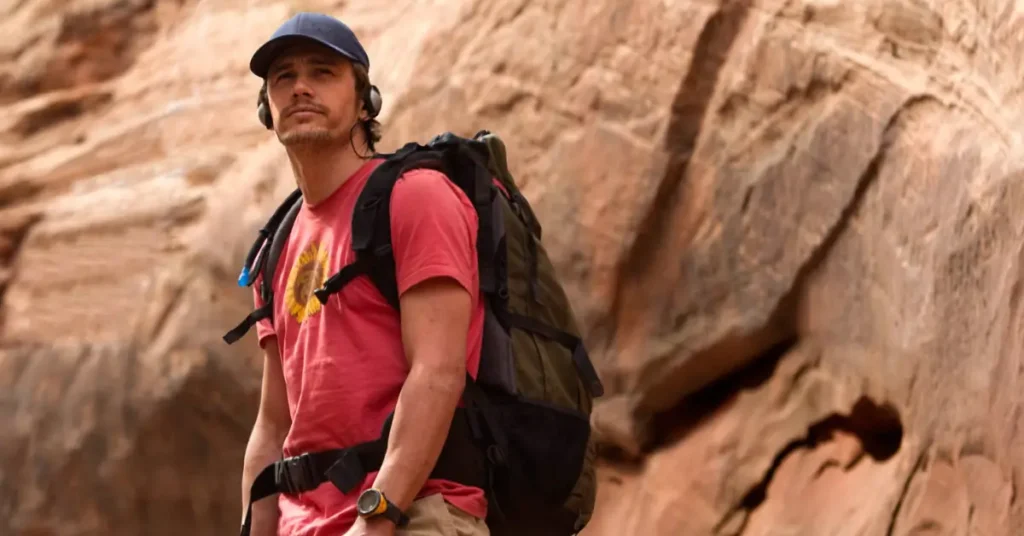127 Hours: Survival, Isolation, and Mental Resilience Under Extreme Duress
When we think about mental health in cinema, we often focus on films that explicitly depict diagnosed conditions. However, Danny Boyle’s “127 Hours” offers something equally valuable a raw examination of the human mind under extreme physical and psychological stress. Based on the harrowing true story of outdoorsman Aron Ralston, this film provides an unprecedented window into how isolation, crisis, and the imminent threat of death impact mental processes, resilience, and the human will to survive.
Thank you for reading this post, don't forget to subscribe!Basic Film Information
Title: 127 Hours
Release Date & Production Year: November 5, 2010 (premiered at Toronto International Film Festival, September 2010)
Director: Danny Boyle
Screenwriter: Danny Boyle and Simon Beaufoy (based on Aron Ralston’s autobiography “Between a Rock and a Hard Place”)
Main Cast & Characters:
- James Franco as Aron Ralston, an experienced but somewhat reckless mountaineer
- Amber Tamblyn as Megan, one of two hikers Aron meets before his accident
- Kate Mara as Kristi, the other hiker Aron encounters
- Clémence Poésy as Rana, Aron’s girlfriend (seen in flashbacks and hallucinations)
- Lizzy Caplan as Sonja, Aron’s sister (seen in flashbacks)
- Kate Burton and Treat Williams as Aron’s parents (seen in flashbacks)
Genre: Biographical survival drama
Awards: Six Academy Award nominations including Best Picture, Best Actor (James Franco), and Best Adapted Screenplay; numerous other awards and nominations
Runtime & Rating: 94 minutes, Rated R (for language and some disturbing violent content/bloody images)
📕 Buy 127 Hours: Between a Rock and a Hard Place on Amazon
Plot Summary
General Overview
“127 Hours” recounts the true story of Aron Ralston, an adventurous mountaineer who becomes trapped in a remote Utah canyon when a boulder crushes his right arm against the narrow canyon wall. With minimal supplies, no cell phone reception, and having told no one of his whereabouts, Ralston spends 127 hours (over five days) pinned in isolation before making the desperate decision to amputate his own arm to escape.
Mental Health Themes
While not focusing on a clinical diagnosis, the film powerfully explores psychological responses to extreme situations: crisis management, isolation-induced hallucinations, suicidal ideation, regret, existential reflection, and ultimately resilience. It examines how Ralston’s mind processes trauma, how he manages hope and despair, and the psychological journey that leads to his life-altering decision. The film also subtly addresses Ralston’s pre-accident personality traits his independence to the point of recklessness, emotional detachment from loved ones, and identity built around self-sufficiency and how crisis transforms these aspects of his character.
Key Turning Points
Several crucial moments mark Ralston’s psychological journey: his initial realization that no help is coming; his methodical inventory of limited resources; his video diary confessions and goodbyes; his hallucinations of past relationships and potential future; his failed attempts to free himself; and finally, his epiphany that amputation is his only survival option. Each turning point reveals different coping mechanisms and mental states as his situation becomes increasingly desperate.
Ending Analysis
The film concludes with Ralston’s successful self-amputation, his difficult journey out of the canyon, and eventual rescue. The epilogue shows the real Aron Ralston continuing his adventurous lifestyle but with greater connection to others. This ending avoids simplistic transformation narratives while suggesting that trauma, when processed, can lead to meaningful psychological growth without erasing one’s core identity. The message is not that suffering is intrinsically redemptive, but that confronting mortality can clarify what matters most in life.

Setting & Cinematic Techniques
Filming Locations
The film was shot primarily in the actual locations where Ralston’s ordeal occurred the Blue John Canyon in Utah. The authenticity of this harsh, beautiful environment is crucial to understanding Ralston’s psychological state. The vast, open landscapes juxtaposed with the claustrophobic confinement of the slot canyon visually represent the paradox of Ralston’s situation: surrounded by expansive nature yet trapped in the smallest of spaces. This contrast heightens the psychological tension and illustrates his mental isolation despite being in such a majestic setting.
Cinematography
Cinematographer Anthony Dod Mantle employs innovative techniques to convey Ralston’s psychological experience. Split screens visualize his fractured thinking and multitasking. Extreme close-ups create claustrophobia and intimate connection with his physical suffering. The camera sometimes adopts Ralston’s literal point of view looking through his video camera or water bottle placing viewers directly in his psychological space. As dehydration and hunger progress, the film’s color palette shifts subtly, becoming more saturated during hallucinations and bleaker during moments of despair, mimicking how perception alters under extreme stress.
Sound & Music
A.R. Rahman’s score and the film’s sound design are crucial to conveying Ralston’s psychological states. The soundtrack alternates between pulsing energy (reflecting his initial freedom and later determination), eerie silence (highlighting isolation), and ethereal compositions during hallucinations. Sound design is particularly effective in representing Ralston’s internal experience amplifying the sound of drinking the last drops of water, the scraping of metal on stone during escape attempts, and most devastatingly, the breaking of bones and cutting of nerves during the amputation scene. These sonic elements make his psychological experience visceral for viewers.
Acting & Character Portrayal
Lead Actor’s Performance
James Franco delivers an extraordinary performance that captures both Ralston’s outward physical deterioration and his complex internal journey. The role demanded portraying a wide range of mental states from problem-solving determination to hallucinatory delirium, from suicidal despair to euphoric realization of how to survive. Franco conveys these psychological shifts primarily through subtle facial expressions and vocal modulations, given the extremely limited physical movement the role allowed. His portrayal of the amputation scene is particularly remarkable, showing not just physical agony but the strange psychological clarity that can emerge in life-or-death moments.
Supporting Cast
The supporting actors appear primarily in flashbacks and hallucinations, effectively representing how relationships exist in Ralston’s mind during crisis. Clémence Poésy as his ex-girlfriend embodies his regret over emotional unavailability, while Amber Tamblyn and Kate Mara represent missed connections and opportunities. Each supporting performance illustrates different facets of Ralston’s psychological processing what he values, what he regrets, and what motivates him to survive.
Accuracy & Authenticity
The film benefits from close collaboration with the real Aron Ralston, who served as consultant and provided his actual video diaries as reference material. This ensures authenticity in depicting both the physical ordeal and the accompanying psychological responses. The film accurately portrays the progression of physical symptoms like dehydration and their cognitive effects, as well as psychological phenomena like time distortion, hallucinations from sensory deprivation, and the clarity that can sometimes emerge in extreme situations.
Mental Health Representation: Strengths & Weaknesses
Psychological Accuracy
“127 Hours” excels in portraying realistic psychological responses to trauma and isolation. It shows the fluctuation between problem-solving rationality and emotional breakdown, the self-soothing behaviors (like creating the video diary), the progression of hope and despair, the hallucinations induced by extreme physical stress, and the complex mental processing required before taking drastic action for survival. The film avoids simplistic portrayals of heroism, instead showing the messy, non-linear nature of psychological response to crisis.
Stigmatization vs. Awareness
Rather than stigmatizing mental struggle, the film normalizes the psychological extremes experienced during trauma. It presents Ralston’s emotional breakdowns, regrets, and even suicidal thoughts as understandable responses to his situation rather than signs of weakness. This approach helps destigmatize psychological distress by showing it as part of the human condition, particularly in extreme circumstances. The film also avoids the potentially problematic “triumph over adversity” narrative by acknowledging that survival involves luck and privilege along with determination.
Impact on Public Perception
“127 Hours” contributes meaningfully to public understanding of psychological resilience and crisis response. It illustrates how the mind processes imminent mortality, how past relationships become psychologically salient during crisis, and how humans can access extraordinary resources when survival requires it. The film also subtly addresses how Western individualism (represented by Ralston’s pre-accident lifestyle) can be both an asset and liability in crisis situations.
Critical Reception & Awards
Critics’ Reviews
The film received widespread critical acclaim, with particular praise for Franco’s performance and Boyle’s direction. Critics noted how the film transcended its potentially limited premise (one man pinned in one location) to become a profound meditation on human connection and survival. Some reviewers found the amputation scene excessively graphic, while others argued its intensity was necessary to convey the psychological magnitude of Ralston’s decision. The movie holds a 93% rating on Rotten Tomatoes, with critics particularly praising its psychological depth.
Audience Reactions
Audiences reported intense emotional and physical reactions to the film, with some viewers fainting during the amputation scene. However, most found the film ultimately uplifting rather than traumatizing. The real Aron Ralston expressed satisfaction with how the film captured not just his physical ordeal but his psychological journey, particularly his realization of how his self-sufficient lifestyle had isolated him from meaningful connections.
Awards & Nominations
The film received six Academy Award nominations, including Best Picture, Best Actor for James Franco, and Best Adapted Screenplay. While it didn’t win any Oscars, it received numerous other awards and appeared on many critics’ top ten lists for 2010. The recognition highlighted how the film succeeded in making an internal psychological journey visually compelling and emotionally resonant.
Cultural & Social Impact
Discussions Sparked
“127 Hours” generated conversations about wilderness safety, the psychology of survival, and the importance of human connection. Mental health professionals noted how accurately the film portrayed crisis response and the mind’s capacity to dissociate from physical pain when necessary for survival. The film also sparked philosophical discussions about what constitutes a meaningful life and how confronting mortality can clarify values and priorities.
Influence on Other Films
The film’s innovative approach to depicting isolated psychological struggle influenced subsequent survival films, encouraging more nuanced portrayals of mental processes during crisis. Its success demonstrated audience appetite for psychologically complex true stories and helped establish James Franco as an actor capable of carrying psychologically demanding roles.
Mental Health Advocacy
While not explicitly created as a mental health advocacy piece, the film contributes to understanding psychological resilience. Aron Ralston has used his story and the film’s platform to discuss the importance of mental preparation for outdoor activities and the psychological impact of survival situations. The film serves as a reference point for discussing how humans respond to extreme circumstances with both vulnerability and strength.
Personal Reflection & Final Thoughts
“127 Hours” provides extraordinary insight into the human mind under duress, particularly how isolation affects perception and decision-making. By immersing viewers in Ralston’s subjective experience including hallucinations, memories, and internal dialogues the film helps us understand the complex psychology of survival situations. It shows how the mind can be both fragile and remarkably resourceful when facing mortality.
I would recommend this film to those interested in psychological resilience and crisis response, though with cautions about its graphic content. It could be particularly valuable for understanding how isolation impacts mental processes and how humans find meaning during extreme suffering. The film offers a rare window into experiences most people will never face directly but can learn from vicariously.
The film could have explored more explicitly how privilege factors into survival stories Ralston’s background, education, and physical conditioning all contributed significantly to his ability to survive. A more nuanced examination of how social factors influence both risk-taking behavior and successful survival might have added valuable complexity to the narrative.

Conclusion
“127 Hours” stands as one of cinema’s most compelling explorations of the human mind under extreme stress. Through innovative filmmaking techniques and Franco’s remarkable performance, it offers viewers unprecedented access to the psychological experience of isolation, crisis, and survival. The film reminds us that mental health isn’t just about diagnosed conditions but about the universal human capacity to process trauma, find meaning in suffering, and discover connection even in the most isolated circumstances.
Beyond its specific focus on survival, the film speaks to broader questions about independence versus interdependence, how we construct meaning in life, and what constitutes true strength. By showing Ralston’s transformation from self-reliant adventurer to someone who recognizes the value of human connection, “127 Hours” suggests that psychological growth often involves integrating seemingly opposed values rather than abandoning one for another.
What are your thoughts on how the film portrays psychological resilience under extreme conditions? Has watching “127 Hours” changed your understanding of how isolation and crisis affect mental processes?

